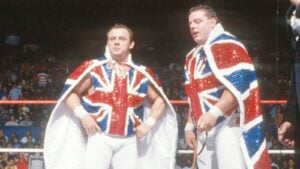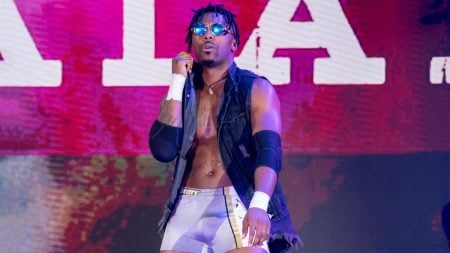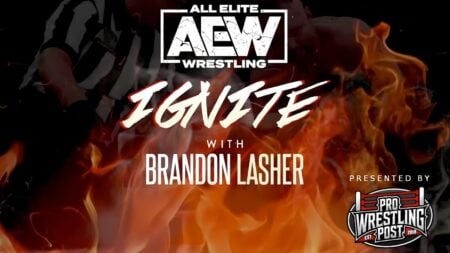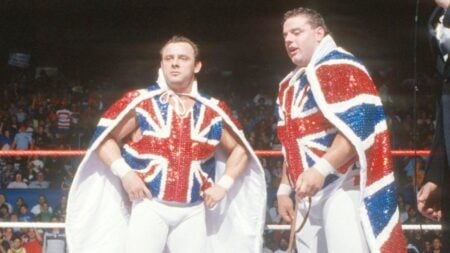High-flying wrestling wouldn’t exist today without Eiji ‘Hayabusa’ Ezaki. He was a pioneer, an innovator, and a trendsetter.
He was so influential that many of today’s top wrestlers have praised and emulated him. Without Hayabusa, there wouldn’t be PAC, the Young Bucks, AJ Styles, or Chris Jericho.
Sadly, Hayabusa’s career was cut short due to a horrifying botch that left him paralyzed. But not even being paralyzed from the neck down was enough to keep Ezaki in one place.
Today we look at the life and career of one of the most innovative and influential wrestlers of the past thirty years: Hayabusa.

Hayabusa –
Before the mask
The Hayabusa character didn’t exist until 1993 and Ezaki began wrestling in late 1987. After spending a few years on Japan’s independent circuit, Ezaki joined FMW in 1991.
Throughout these early years, Ezaki lost most of his matches, which was customary given his rookie status.
He also had to endure intense hazing by the FMW veterans to make sure he had the toughness needed to survive in that company. Mike Awesome once recounted how much Ezaki endured:
“He [Ezaki] was hazed unmercifully. The veterans were extra stiff with him in the ring. They would steal and vandalize his property. They called him all sort of unflattering names.
And on a few occasions, he was stripped naked, tied to a pillar, and had bottle rockets placed in his rear, which were then lit to fire out of him.”
These acts of hazing toughened Ezaki up and allowed him to continue wrestling for FMW. And it was also during this period that he was first exposed to the lucha libre style, first in small doses.
Many of the foreigners coming to FMW were Mexican and wrestled in the light heavyweight style. Inspired to learn more, Ezaki went on a foreign excursion to Mexico in late 1993.
The (original) Aerial Assassin
In December 1993, Ezaki adopted the Hayabusa character the first time while in Mexico. During that excursion, he learned more about lucha libre from Rey Mysterio Sr. and worked for various promotions throughout Mexico.
Then, on April 16th, 1994, Japanese wrestling fans got to see Hayabusa for the first time.
Hayabusa made his Japanese debut in the fabled Super J Cup tournament. His opponent was another legendary junior heavyweight (and also the mastermind behind the tournament itself), Jushin ‘Thunder’ Liger.
Although Hayabusa lost to Liger, he dazzled audiences in his match with Liger. He created an iconic visual when he spin-kicked Liger out of the ring and then dove over the top rope with his coat still on.
This served as the launching pad for Hayabusa’s career as it exposed him to a much bigger audience than anything he had experienced before.
Hayabusa remained in Mexico until mid-1995 so that he could better master the lucha libre style and polish his skills. During this period, he was approached by WWE but turned them down out of loyalty to FMW.
Ace
By 1995, Hayabusa was poised to become the new ace of FMW. His unique look and daredevil acrobatics made him a sight to behold in Japan. But what differentiated him from another red-colored masked junior was his penchant for hardcore wrestling.
Whereas his NJPW equivalent, Liger, kept things ‘pure’ and wrestled ordinary matches, Hayabusa loved the extra violence. He was completely fine wrestling in the most insane stipulations imaginable.
During his prime, it wasn’t uncommon to see Hayabusa wrestling in matches involving barbed wire, explosions, objects wrapped in barbed wire, and so forth.
And after FMW star Atsushi Onita allowed him to kick out of his terrifying finisher, the Thunder Fire Powerbomb, it signaled to everyone that Hayabusa was going to carry FMW into the future.
But this transition wasn’t easy. For many long-time fans, FMW was Onita’s company. He was the centerpiece of the company and Hayabusa represented a change they didn’t want to accept.
So even though Hayabusa was booked by the company to become ace, the fans didn’t go all-in with that from the beginning. So Hayabusa had to work much harder to get the fans behind him. And he accomplished this by creating some truly impressive moves.
It was around this time that Hayabusa developed and mastered his three most famous moves: The Falcon Arrow slam, the Firebird Splash (more commonly known in North America as the 450° splash) and the Phoenix Splash.
There was considerable coverage in Japanese wrestling magazines over Hayabusa and these moves, and they helped elevate him even further.
The Most Popular Wrestler In FMW
By 1996, Hayabusa was the most popular wrestler in FMW. He wrestled the top stars and was in the biggest matches. He began wrestling hardcore stars like Mike ‘The Gladiator’ Awesome and Masato Tanaka, all while working through accumulating injuries.
His star power continued to rise when he and Tanaka faced Mr. Pogo and Terry Funk in a no-rope-explosive-barbed-wire-time-bomb-land-mind-double-hell-death-match on FMW’s 7th Anniversary Show (which is one of the best ‘garbage wrestling’ tapes of its era).
Soon, his reputation grew to the point that wrestlers from other promotions wanted to wrestle him.
First came Jinsei Shinzaki, better known as Hakushi in WWE. Shinzaki fought Hayabusa in a classic singles match at the 1996 Year End Spectacular show. Then, AJPW owner Giant Baba and Hayabusa worked together to create a working relationship between Baba’s AJPW and Hayabusa’s FMW.
This led to several interesting inter-promotional match-ups that were once thought impossible, given Baba’s isolationism. This led to Hayabusa having highly acclaimed matches with the likes of Mitsuharu Misawa, Jun Akiyama, Kenta Kobashi, and Yoshihiro Takayama.
He even won AJPW’s All Asia Tag Team Championships alongside Shinzaki, which was a rare feat given that he was an outsider in a tight-knit company.
As if that wasn’t enough, Hayabusa was also brought to the United States to wrestle for ECW Heatwave 1998.
On that show, Hayabusa and now-partner Shinzaki faced Rob Van Dam and Sabu for the ECW World Tag Team Championships in another highly acclaimed match.
Although he didn’t cut promos, the audience loved Hayabusa for his RVD-style acrobatics and his badass aesthetic.

Hayabusa | The Later Years
By 1999, Ezaki had accumulated too many nagging injuries to keep wrestling in the lucha style. He began to wrestle in a more ground-based style and more weapons-based matches at the expense of high-flying.
To cement this change, a character transition occurred as well. Ezaki unmasked and wrestled as ‘H’ for quite some time. This period saw him wrestle in jeans or in wrestling trunks, looking less like a badass wrestling ninja and more like a more ‘typical’ wrestler.
This helped give more meaning to his work as Hayabusa while also giving more freshness to his new character direction.
It also marked some strange matches for him one of the weirdest matches saw Ezaki (as ‘H’) wrestle an imposter Hayabusa (played by Mr. Gannosuke) with Shawn Michaels as the guest referee. It was definitely a strange time.

A brutal end
By 2001, Ezaki returned to the old Hayabusa character and had gone back to his high-flying ways. But things took a tragic turn for him on October 22nd, 2001. Hayabusa botched a lionsault, a move he had done countless times before, slipping and landing hard on his neck.
He cracked two vertebrae with that botch and was paralyzed instantly. In a split second, Ezaki had gone from flying around and above the ring like a falcon (which is the literal translation of the word ‘Hayabusa’) to being wheelchair-bound for the rest of his life.
The immediate months following this catastrophic injury were the darkest for Ezaki. With his L4 and L5 vertebrae cracked, he was numb below the neck, and the only sensation he could feel was biting his own tongue.
He was now powerless to do anything. Nurses had to move him to avoid him getting bedsores, and they had to change his diaper because he couldn’t go to the bathroom. He became hopelessly depressed, wishing to commit suicide due to how low he had fallen.
But even though an open window was only a few feet away, he couldn’t even move himself over to do so.
Things got darker for him as his condition worsened. He developed relapsing fevers that caused him to hallucinate. Hayabusa couldn’t distinguish between dreams and reality.
He suffered brief kidney failure and his weight dropped from 232 pounds to 127 in the span of months.
Then he had to have life-saving open-heart surgery due to being unable to move and bacteria getting into his heart.
Hayabusa | An Inspiration
And yet, despite all this anguish and hopelessness, Ezaki still received support from fans and co-workers. After his condition stabilized, he received multiple visitors in the hospital.
From FMW co-workers to people from other companies (Kobashi, Misawa, Sasaki, Dragon Kid) to his family, all came to visit him and offer support.
At one point, former FMW owner Shoichi Arai brought in a sack full of 1,000 fan letters, all to Ezaki to encourage him to get better.
And get better, he did.
It was a long and arduous process, but Eiji Ezaki gradually got better. He’d never wrestle again, but he was able to recover some mobility and use of his arms at first. But he gradually became able to do a bit more each time.
Stand with the help of canes attached to his arms. Move two feet forward. Then walk ten feet. Then climb some stairs.
Bit by bit, Ezaki got better. He even managed to walk into a ring in 2015 with the help of a cane, proving that it was indeed possible to overcome seemingly impossible odds.
Sadly, Ezaki passed away on March 3rd, 2016, from a cerebral hemorrhage. He was 47 years old. Soon after, tributes came pouring in from wrestlers all around the world.
Hayabusa | Legacy
Hayabusa was a pioneer in junior heavyweight wrestling. He was able to combine lucha libre with the Japanese style along with hardcore and deathmatch elements in a way that few others could.
When he dove off the top rope, he got unbelievable airtime. He executed his Phoenix Splash effortlessly, moving with such fluidity and grace as if he was born to fly.
Hayabusa inspired many of today’s top wrestlers to some degree. Many wrestlers have used his signature moves, including Seth Rollins, PAC, AJ Styles, Kalisto, Sami Zayn, just to name a few.
He helped change the mindset of pro wrestling promoters and of fans. Hayabusa proved that a high-flyer could carry an entire promotion.
He became the unquestioned ace of FMW and won their world championship multiple times. This was a big deal in monolithic Japan, which has long clung to the notion that only heavyweight – and not high-flyers – are strong enough to be aces.
So for Ezaki to prove them wrong shattered that presupposition and helped pave the way for many other smaller and more agile wrestlers to follow in his footsteps.
Without Hayabusa, the modern wrestling landscape would be a very different place. There wouldn’t’ve been that shift to pure athleticism and acrobatics that has come to define the modern wrestling landscape. Whether that’s entirely a good thing or bad is open to interpretation.






